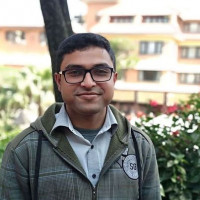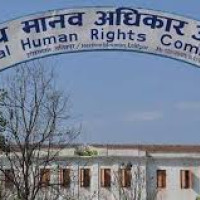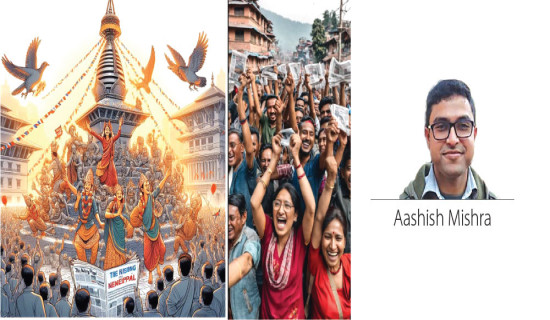- Friday, 26 December 2025
Destroyed Phalcha, displaced god
Lalitpur, Mar. 19: An indistinct brick-and-cement platform across the street from Patan’s famous golden water spouts at Sundhara. An inconspicuous quadrangle at the bustling heart of the place named heart (Nugah) in the native Nepal Bhasa. It is an unabashedly bland structure, possessing few features that attract the eye. It has no decorations, no markings or inscriptions, or even a name. People just call it the Dabali (elevated stage) of Sundhara. Those who look at it may find no cause to wonder if it was ever anything more than the unremarkable podium it is today.
But Rajib Shrestha, an ex-member of Lalitpur Metropolitan City’s Ward No. 6 and a resident of Sundhara, knows it was. “It was a two-storeyed Phalcha that was an exquisite example of traditional Newa architecture,” he told The Rising Nepal. “The building was beautiful with windows artistic beyond measure,” he recounted the description he had heard from his 81-year-old father. “And, it housed the special Pwa Sya Dya.”
Pwa Sya Dya, whose name translates to the stomach-ache deity, was a god like no other. Enshrined on the ground floor of the Phalcha, the Nepal Bhasa word for a public shelter, it was venerated for curing gastrointestinal ailments.
“People came from far and wide to worship the Pwa Sya Dya,” Shrestha shared what it was like in the past. “They would bring rice in a traditional earthen chalice ‘Salincha’, put a coin and a betel nut on it, have the person with the hurting tummy bow down to it with his or her forehead and then offer it to the god.”
“Within a day or two, they would be cured of their pain.”
Shrestha also informed that the Dya was worshipped as an incarnation of Gorakhnath on occasions.
“When it existed, Pwa Sya Dya was the only god of its kind in Kathmandu Valley,” asserted Rajendra Shakya, a Newar Studies scholar who has researched the deity and the building it was consecrated in for the Nepal Heritage Documentation Project (NHDP).
Through photographic, iconographic and epigraphic studies, the Project, led by the Heidelberg Centre for Transcultural Studies at Heidelberg University, Germany, has been studying and documenting Nepal’s heritage sites and monuments since 2018.
As per the information compiled by NHDP, Pwa Sya Dya was not only unique in its healing powers but also its appearance. Its stone idol depicted the divinity as unclothed, having a large belly.
Legend has it that the idol had life and would sometimes walk out of its sanctum to drink water from Sundhara’s golden spouts on the opposite side of the road. When doing so, it would only drink the water flowing from the
middle spout while closing the mouths of the other two spouts on its left and right with its hands.
People believed that touching the
navel of the Pwa Sya Dya and drinking the water coming out of Sundhara’s fountains would rid them of their stomach pains. “This was a practice of faith that showed the vibrancy of our culture, the importance of the Phalcha and the medicinal value of Sundhara’s waters too,” Shrestha said. Why and how, then, did it disappear? Where did the god go and what happened to the magnificent house it resided in?
According to locals, the Phalcha was damaged when the locality members, angry at the arrest of some of their youths, tried to storm the police station that was based in it in the 1970s. The damages were never repaired, the police station also moved out and the structure gradually grew dilapidated and collapsed.
Former elected representative Shrestha remembers the Pwa Sya Dya statue remaining out in the open after the Phalcha’s destruction. “But after some time, it too went missing. Nobody knows what happened to it,” he stated.
Before its demolition, the Phalcha was managed by the members of the Chipalu community who lived at Chanki, around 100 metres from Sundhara. However, many of them have since emigrated to other places and could not be contacted for this news.
We do not know how old the Phalcha or the Dya was as there are no steles or documents in existence but Shrestha believes that they dated back to the Malla era.
After its razing, the erstwhile Phalcha was turned into an open platform which is how it has remained since. But for a brief period eight years ago, people were able to see how it once looked when students from Kathmandu University Centre for Art and Design constructed a replica, true to its original dimensions, from iron and white fabric.
It was for the ‘Patis in Patan’ exhibition at the first Photo Kathmandu festival in 2015 and was part of a larger initiative including members of Heidelberg University, Kathmandu University and Kathmandu Valley Preservation Trust.
Sujan Chitrakar, artist and art educator associated with Kathmandu University, said that, with the construction, they hoped to “refresh the memory” because, “In our discussions with the locals, we found that people had started forgetting about the existence of the Pwa Sya Dya and the Pwa Sya Phalcha.”
Dr. Christiane Brosius, professor of anthropology at Heidelberg University, said that it was also an effort to “uncover intangible memory” as the team had nothing but oral accounts and an old photograph to work from.
By weaving memories, Brosius, Chitrakar and group managed to rebuild a memory in cloth and when the structure finally went up, “People were surprised. They realised that something stood there,” Chitrakar recalled people’s reactions. In the context of the annihilation brought by the earthquake that struck Nepal in April of that year, the exhibit also held a symbolic meaning of portraying an old tumbled structure getting back up.
As Professor Brosius said, “People should not accept that something is lost forever. Reconstruction, if wanted by local communities, can be meaningful for belonging.” She added that the selection of the Pwa Sya Phalcha, as well as the entire ‘Patis in Patan’ exhibit was also aimed at calling attention to the documentation and restoration of monuments beyond the “five-star” heritage sites enlisted by UNESCO as world heritages – something she works towards with Indologist Professor Dr. Axel Michaels and a vibrant team of Nepalese historians, architects and photographers at NHDP.
With regard to Pwa Sya Phalcha, both Brosius and Chitrakar hoped the exhibition would nudge people to think about its reconstruction. Shrestha, too, wants the Phalcha, which he called “one of the gems of Nugah”, to be rebuilt and is willing to extend any assistance necessary. But Lalitpur Ward No. 7, under whose jurisdiction the Phalcha lies, has not made any such plans yet, worried that a multi-storey structure here would make it harder to pull and rotate (Yaa Nyayegu) the chariot of Red Machhindranath during the Sundhara leg of its annual Jatra.








-square-thumb.jpg)




